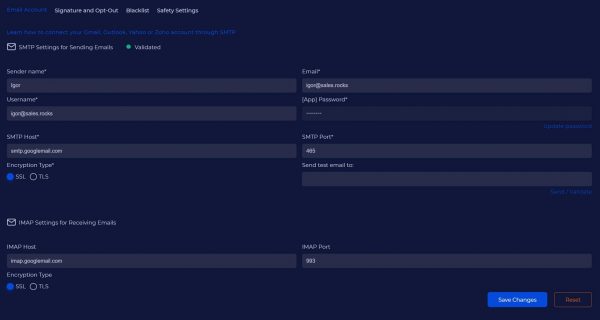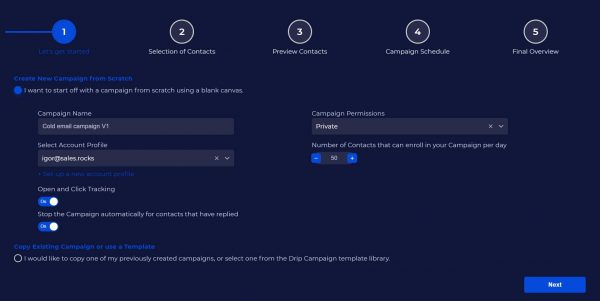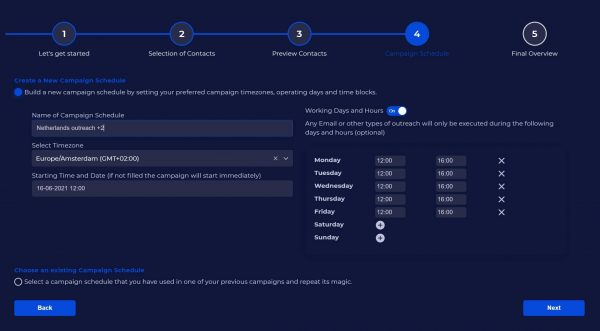Updated on January 26, 2022
Sending cold emails is the bread and butter of every sales and marketing outreach. It is the most common and most effective way of reaching out when it comes down to the return of investment. Connecting with prospects or building relationships with leads, cold emails are your first and best option due to their potential and the number of ways they can be used for different types of outreach.
This guide will teach you how to send your cold emails with the help of the Sales.Rocks drip campaigns module. But before we get to that part, you just need to do one thing.
Set up your email account
First things first. You’ll need to connect your email account with Sales.Rocks. It’s pretty straightforward if you follow this how-to article. If you did everything correctly a green message will pop up to let you know you’re good to go (rhyme unintended).

Here you can also set up a custom signature and set the delay between the emails.
Sending cold emails with Sales.Rocks
Now let’s go through the steps on how to send cold emails using the app, including a couple of tips to make sure you’re getting the most out of your cold email outreach.
Different email domains for outreach
Should you use another domain for sending cold emails?
The answer is, it depends. To give you an example we use @sales.rocks for customer support, lead nurturing, and most of our marketing outreach. The sales team is also using it for a smaller outreach campaign, however, for larger cold email campaigns they are using another domain to be on the safe side.
So when does it make sense to use another domain?
-
- If you’re sending a low number of emails to a smaller email list, stick to your main domain.
- If you have a big sales team, however, that has to contact a high number of prospects by sending a large batch of cold emails that can quickly max out your email sending limit. Use another domain.
Number of sent cold emails per day
When it comes to sending cold emails, I’m a quality over quantity kind of guy. From my experience, spending a bit of extra time on research before reaching out to people allows you to better personalize the emails. And that is more important than the number of emails you send. Because in the end, the number of opened emails is not as important as how many got a positive reply back.
It all comes down to which do you think is better?
Sending 100 emails and getting 30 replies or sending 300 emails getting the same number of replies?
Sure you got the same number of replies but in terms of time and resources spent on research and finding the emails then the first campaign definitely comes out on top. Just keep in mind that more is not always better and focusing on more accurate targeting and better messaging will yield great results.
Now, if you really need to reach out to a large number of prospects that’s understandable, and what you shouldn’t do is send all emails on the same day. Sending a large batch of emails is risky, especially if you do it irregularly.
Although we don’t limit how many emails you send per account we strongly recommend sending under 50 emails per day. So if you have a list of 250 prospects you need to contact, it’s best to spread out the emails over the week.

P.S. Don’t forget to turn on Open and Click Tracking so you know how well your campaigns are performing.
As for the rest, we have you covered. You can set the starting time and date, select a specific time zone and schedule the emails to be sent on a specific day and time of day.

The app will also take into account the minimum and maximum delay between the emails being sent.
Warm-up your email account
The success of your cold emails depends on them arriving in the inbox and not ending up in the spam folder. That can happen if you try to send a lot of emails from a new email domain or one with a low email sender reputation. This is where email warming comes in handy.
What is an email warm-up?
Email warm-up is a way to quickly and safely improve the reputation and increase the sending limit of your email account.
Basically, our email warmer automates the process of sending and replying to emails, simulating a back and forth between the emails being warmed up.
Additional tips:
Daily ramp-up increment
For email accounts 1 to 3 months active, we recommend you set an increment of 1 to 2 and for email accounts 4 to 6 months active, you can set the increments from 3 to 4.
Ramp-up limit
For email accounts 1 to 3 months active, we recommend you set the limit of daily emails sent to 25-35 and for email accounts 4 to 6 months active, you can set the daily limit of email sent to 35-50.
The email warm-up process lasts a month, but you can let it run longer if you don’t plan on using the email account frequently. This way the email will have its sending frequency intact.
You can find more information about the email warmer here.
The right sales tool for your sales
Sell more with Sales.Rocks
Improve your bounce rate
There are a number of reasons why an email can bounce back. Usually, the receiving email server gives you a coded message why your email bounced.
For example, the mailbox of the person you are sending an email to may be temporarily unavailable due to network issues. This is registered as a soft bounce.
Another very frequent reason for emails bouncing is a bad email address. This is called a hard bounce and it directly contributes to your bounce rate and it can cause you a lot of headaches.
The best thing you can do to avoid a high bounce rate and the negative consequences that come with it and that can also impact your email deliverability and email sending reputation is to always verify your emails and keep your email list clean.

Fix your email deliverability
A low email open rate even though you put the time and effort to research your prospects and personalized the message accordingly, is a sure sign of email deliverability issues.
You can check your SPF, DKIM and DMARC configurations as well as a couple of other things that can impact your email deliverability.
If you’re feeling up to it (don’t worry it’s easy) you can do a quick email deliverability audit on your own and to make sure everything is covered.
Cold email basics
Making your cold emails interesting and engaging can be hard. So here are some cold emailing tips and best practices you’ll find worthwhile.
Find information and emails
A good cold email campaign depends on how good the information you have is. That means spending a good amount of time researching your target prospects. Based on that you know if they will be interested in your email or not. But finding up-to-date info that is reliable without wasting a lot of time is not always easy. And manually doing it, just isn’t a good idea, especially if we’re talking about a large number of prospects.
Your only option is to automate that part of the process. If you have prospects lists saved on the app, you can seamlessly transfer the prospects you want from your list directly into your email campaigns or you can import the data through one of these options.
If you have trouble finding the necessary emails, here are some ideas.
The subject line and email body are key
Personalization is the key to making your cold email stand out from the crowd. Use the information you have on your prospects to make the email seem tailored to them specifically.
A subject line is like the plot synopsis to a movie you’re deciding to watch on streaming. If it doesn’t get your attention and makes you interested in watching it, you’ll just skip it. Make sure your subject line gets the attention of your recipients.
When it comes to the email body, the intro should immediately let the recipient know who you are and what they can expect from the email. Set their expectations appropriately and don’t pull a bait and switch. Present yourself, be upfront, and lay the base for the sales pitch.
Present your product while you’re addressing the problem they are facing. By presenting it this way it gets the point across in a way they can relate to and quickly see the value in what you offer. Here’s a little something to help you with writing a well-performing cold email.
Set up the email sequence
You’ve imported your email list and prospect data, customize the email and now it’s time to build the campaign. You can edit and email delays and conditions through a drag & drop style builder.
The tags you’ve set in the email template will be auto-filled based on the data, however, if there’s a piece of data missing we have a neat feature called “Fallback” that you can set to replace a missing tag.
Here’s a detailed guide on how to set up your campaign.
Also, spoiler alert! We have LinkedIn automation coming soon. In case you want to spice up your cold outreach.
Always follow up
One email and you’re done, that’s not how cold emailing works. Most of the time prospects reply after several follow-ups. This allows you to send them a quick reminder follow-up or send additional follow-ups as a way to add to the first cold. When you do send a follow up leave a bit of breathing room between emails. Typically two or three days in between emails is the standard.
Track your email metrics
Finally, after the emails are sent it’s time to check the results. It is important to keep track of your effort and the performance of your campaign. Analyze your open, click and reply rate to see if there’s some area that needs improvement.
Now it’s your turn
You’re all set, but keep a few things to keep in mind before you go off and start your cold email campaign. Always verify the emails before you send as even a couple of bad email addresses can mess with your email deliverability and your bounce rate, not to mention the performance of your campaign.
Focus more on researching your prospects and sending a relevant email instead of just reaching out to a large number of prospects that you aren’t sure will be interested in your offer. Good luck with your cold emails!
Improve your selling skills


